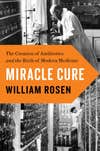How the first broad-spectrum antibiotic emerged from the Missouri dirt
Excerpt: Miracle Cure

The following is an excerpt from Miracle Cure by William Rosen
The perennial known as timothy grass, which grows from two to five feet tall, covers thousands of acres of the American Midwest. It is famously hardy, resistant to both cold and drought, and prospers in almost any kind of soil, from the heaviest bottomland to the poorest sands. Like many New World plants, it is a relatively recent invader, introduced to colonial America by European settlers— one popular theory suggests that the name comes from an eighteenth-century New England farmer named Timothy Hanson—and it is widely grown as animal feed for everything from domestic rabbits to cattle and horses.
Timothy grass was and is important enough as a commercial commodity that agronomists at the University of Missouri started planting it in Sanborn Field, the university’s agricultural test station, as soon as it opened in 1888. They were still experimenting with it—testing varieties for improved yields, or more weather hardiness—in 1945 when William Albrecht, a soil microbiologist, received a letter from a former colleague, now working in New York. The letter included a request that Albrecht obtain soil samples from a dozen different Missouri locations, including Sanborn Field’s Plot 23. Its author was a botanist and mycologist named Benjamin Minge Duggar.

Duggar was then seventy-three years old and an accomplished and respected plant pathologist. Ever since receiving his PhD in 1898, he had studied fungi and disease, more or less nonstop, at the Department of Agriculture and at a number of prominent land-grant universities including Cornell, the University of Wisconsin, Washington University in St. Louis, and, of course, Missouri.1 In 1944, he departed his last academic post and joined Lederle Laboratories to work under its remarkable head of research, Dr. Yellapragada Subbarao.
Lederle Antitoxin Laboratories, as it was originally known, had been founded in 1904 by Dr. Ernst Lederle, a former New York City health commissioner, to produce an American version of the diphtheria vaccine developed by Emil Behring, Paul Ehrlich, and Robert Koch at the end of the nineteenth century, one they could sell to American physicians and hospitals royalty free. Vaccines and antitoxins, for tetanus, typhoid, anthrax, and smallpox, remained the company’s primary business for the next forty years, through the death of its founder in 1921, its subsequent acquisition by the agricultural chemicals manufacturer American Cyanamid in 1930, and the hiring of Subbarao in 1940.
Subbarao, an Indian-born physician and physiologist, arrived in the United States as a penniless immigrant in 1923, but with an admissions letter to Harvard University’s School of Tropical Medicine, a division of the university’s medical school. His tuition expenses were paid by his father‑in‑law, but in order to pay for his room and board he was given a job at Harvard Medical School, where he spent the next seventeen years. His achievements were nothing short of stellar; among other endeavors, he isolated the components of adenosine triphosphate, or ATP, the fuel for all cellular respiration. In fact, a complete account of Yellapragada Subbarao’s accomplishments is almost literally too long to list—not only fundamental discoveries about ATP, creatine, and of B12, but half a dozen chemical breakthroughs still in use today, including discovering how a mimic of folic acid known as antifolate could be used to combat leukemia. Despite that, U.S. immigration law’s baroqueries (among other things, immigrants from British India were allowed to stay only if they fell into professional categories that the State Department deemed valuable. . . a list that changed regularly) required him to register as an alien for his entire professional career.
The most consequential result of Subbarao’s problematic immigration status is that one of the university’s most brilliant investigators was denied tenure. Academia’s loss was industry’s gain; in 1940, he left to join Lederle as its director of research. A year after that, he represented Lederle at the first meetings of the Committee on Medical Research called by A. N. Richards to discuss what would become the penicillin project. Three years after that, he hired Benjamin Duggar.
By this time, Selman Waksman’s researches at Rutgers were making him the most famous soil scientist in the world; more, they were inspiring everyone in the entire discipline to emulate his approach: testing literally thousands of actinomycetes for antibacterial properties. It certainly inspired Subbarao and Duggar, who initiated a global program of soil collection. Remarkably enough, in the middle of the world’s largest war, they successfully recruited dozens of soldiers and sailors to seek out soil samples everywhere from the Caucasus to North Africa to South America. In 1945, they hit pay dirt—literally—closer to home, with the sample from Plot 23 at Sanborn Field. Living in Plot 23 was a yellow actinomycete, a relative of Selman Waksman’s Streptomyces griseus that they designated A‑377. It took nearly three years of testing and experiment before Duggar announced his discovery to the world in an article in which he named his newly discovered organism Streptomyces aureofaciens: the “gold maker.”
The name was almost certainly an attempt to describe the appearance of the bacterium, but Duggar’s employers at Lederle may have had a different meaning in mind. S. aureofaciens produced a chemical of unknown identity and structure, but one that checked the activity of an enormously wider variety of bacteria than either penicillin or streptomycin. The substance, which Duggar christened Aureomycin (aurum is Latin for gold), was effective against Gram-positive and Gram-negative bacteria, including the pathogens responsible for common ailments like urinary tract infections, and rare ones like bubonic plague. It even seemed to have a powerful effect against a number of viruses. The first broad-spectrum antibiotic had been discovered.
In 1948, after a series of highly successful animal experiments, Aureomycin was ready for clinical investigation in humans. The facility chosen was Harlem Hospital, where Louis Tompkins Wright had spent years studying the treatment of diseases, such as the sexually transmitted lymphatic infection caused by the bacterium known as Chlamydia trachomitis. Wright—the most famous African American physician in the United States, the first admitted to the American College of Surgeons—succeeded brilliantly, not just against chlamydia, but also on the variety of pneumonia caused by a virus, rather than the pneumococci bacteria.
Aureomycin looked like a true magic bullet: the hoped-for drug that would cure nearly everything. The Harlem Hospital results didn’t convince everyone; Maxwell Finland of Harvard Medical School, perhaps the country’s most respected expert on infectious disease, found that Wright’s reports were “tinged with enthusiasm,” and he didn’t mean it as a compliment. In 1948, this made him a voice in the wilderness. Lederle promoted it as “the most versatile antibiotic yet discovered, with a wider range of activity than any other known remedy.” It wasn’t just that it was superior to existing antibacterial treatments in treating disease (though it was). Unlike Prontosil, or penicillin, or—thanks to George Merck—even streptomycin, Aureomycin was patentable, and, on September 13, 1949, it was granted U.S. patent number 2,482,055. Even before the patent had been approved, in 1948 the company spent a then-unheard‑of $2 million shipping samples of their gold maker to 142,000 doctors. Lederle had the first blockbuster drug in history, but it wouldn’t have the stage to itself for long.
The land-grant colleges were, like the Agriculture Department itself, a creation of the 37th United States Congress, which passed the Morrill Act—named for its author, Vermont congressman Justin Smith Morrill—in July 1862 to “teach such branches of learning as are related to agriculture and the mechanic arts. . . .” In the same way as the Northern Lab and Selman Waksman’s lab at Rutgers, they are a reminder of the unpredictable but enormous returns earned by national investment in basic research. ↩︎
Excerpted from Miracle Cure by William Rosen, with permission of Viking, an imprint of Penguin Publishing Group, a division of Penguin Random House LLC. Copyright © 2017 by Jeanine Rosen.